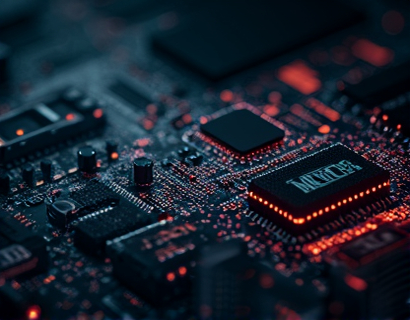Decentralized Trading Powered by Advanced Smart Contract Automated Market Makers
The landscape of financial trading is undergoing a transformative shift with the advent of decentralized finance (DeFi) and the integration of advanced smart contract technology. This evolution is particularly evident in the realm of decentralized trading, where Automated Market Makers (AMMs) powered by smart contracts are redefining the way traders interact with markets. This article delves into the future of decentralized trading, exploring how advanced smart-contract AMMs are revolutionizing the trading experience, optimizing liquidity management, and enhancing strategic execution for crypto traders and DeFi enthusiasts.
Understanding Decentralized Trading and AMMs
Decentralized trading refers to the process of buying and selling digital assets on blockchain-based platforms, eliminating the need for intermediaries such as exchanges or brokers. This peer-to-peer trading model is facilitated by smart contracts, self-executing contracts with the terms of the agreement directly written into code. Automated Market Makers, a key component of DeFi, serve as decentralized exchanges (DEXs) that automatically determine the price of assets based on the supply and demand dynamics within the liquidity pools they manage.
Traditional AMMs use algorithms to calculate prices, typically based on a simple formula like the constant product market maker (CPMM) model, which maintains the product of the two assets in a liquidity pool constant. However, advanced smart-contract AMMs take this a step further by incorporating more sophisticated models and features, enhancing liquidity, reducing slippage, and improving overall trading efficiency.
Advantages of Smart-Contract AMMs
The integration of advanced smart contracts in AMMs brings numerous benefits to the trading community. One of the primary advantages is the enhanced liquidity provided by these platforms. Liquidity pools in smart-contract AMMs can attract a wider range of assets and larger volumes, thanks to the transparency and trustlessness inherent in blockchain technology. This increased liquidity translates to better market depth and tighter spreads, making it easier for traders to execute large orders without significantly impacting prices.
Another significant benefit is the reduced risk of censorship and manipulation. Since smart contracts operate on a decentralized network, there is no central authority that can alter the terms of the trade or freeze assets. This ensures a higher level of security and fairness in the trading process. Additionally, the transparency of smart contracts allows users to verify the code and the state of the liquidity pool, fostering trust among participants.
Optimized Liquidity Management
One of the most critical aspects of decentralized trading is liquidity management. Advanced smart-contract AMMs offer sophisticated tools and mechanisms to optimize liquidity pools, ensuring that they remain attractive to both liquidity providers and traders. For instance, some platforms implement dynamic fee structures that adjust based on market conditions, incentivizing more liquidity during periods of low activity and reducing fees during high-volume periods to maintain liquidity.
Another innovative feature is the use of governance tokens, which allow the community to propose and vote on changes to the AMM parameters. This decentralized governance model ensures that the AMM evolves in line with the needs and preferences of its users, fostering a more adaptive and responsive trading environment. Liquidity providers can also benefit from staking their tokens to earn additional rewards, further incentivizing participation in the liquidity pools.
Enhanced Trading Strategies and Execution
For traders, the integration of advanced smart contracts in AMMs opens up a plethora of strategic opportunities. One such advantage is the ability to implement complex trading strategies with greater ease and efficiency. For example, traders can use the AMM to create arbitrage opportunities by exploiting price discrepancies across different DeFi platforms. The low latency and high execution speed of smart-contract AMMs make it possible to capture these opportunities in real-time.
Another strategic advantage is the use of stablecoin pairs and synthetic assets within liquidity pools. This diversification reduces the risk associated with price volatility and allows traders to hedge their positions effectively. Additionally, the programmability of smart contracts enables the creation of custom trading protocols, such as yield farming and liquidity mining, which can further enhance the trading experience and reward active participants.
User Experience and Accessibility
The user experience on decentralized trading platforms powered by advanced smart-contract AMMs is designed to be intuitive and accessible. The interfaces are built with user-friendly designs, making it easier for both novice and experienced traders to navigate and execute trades. The integration of wallet connections and on-chain transactions simplifies the process, reducing the need for external wallets and enhancing security.
Moreover, the transparency of blockchain technology allows users to monitor their trades and liquidity positions in real-time. This level of visibility not only builds trust but also empowers users to make informed decisions based on current market conditions. Educational resources and community support further enhance the accessibility, helping users understand the intricacies of decentralized trading and AMMs.
Challenges and Future Developments
Despite the numerous advantages, decentralized trading powered by smart-contract AMMs is not without challenges. One of the primary concerns is the complexity of smart contracts, which can lead to bugs and vulnerabilities. The decentralized nature of these platforms also means that there is no central entity to address issues or provide customer support, although community-driven solutions are increasingly addressing these gaps.
Looking ahead, the future of decentralized trading is promising. Continuous advancements in smart-contract technology, such as improved scalability solutions and enhanced security features, will further solidify the position of AMMs in the DeFi ecosystem. The integration of oracles for real-world data, interoperability between different blockchain networks, and the development of cross-chain AMMs are some of the exciting developments on the horizon.
Conclusion
The evolution of decentralized trading through advanced smart-contract AMMs represents a significant leap forward in the world of DeFi. By offering optimized liquidity management, enhanced trading strategies, and an superior user experience, these platforms are set to redefine the trading landscape. As the technology continues to mature, crypto traders and DeFi enthusiasts can look forward to a more efficient, secure, and rewarding trading experience. Embracing these advancements will be crucial for staying competitive and capitalizing on the opportunities presented by the decentralized finance revolution.











































